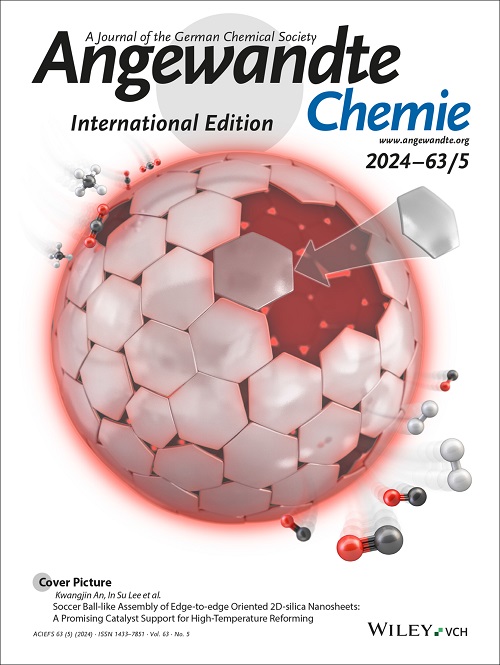Escape from Flatland: Stereoselective Synthesis of Hexa-aryl Borazines and their sp²-Based 3D Architectures
IF 16.1
1区 化学
Q1 CHEMISTRY, MULTIDISCIPLINARY
引用次数: 0
Abstract
Borazine and its derivatives can be considered critical doping units for engineering hybrid C(sp2)-based molecules with tailored optoelectronic properties. Herein, we report the first synthesis of hexaarylborazines that, bearing ortho-substituted aryl moieties, extend three-dimensionally. Using a one-pot protocol, we first form an electrophilic chloroborazole and then react it with an aryl lithium (ArLi). By selecting the appropriate ortho-substituent, we can guide the ArLi to add to the BN-core in a specific way, ultimately controlling the stereochemical outcome of the three-substitution reaction. Rationalization of the stereochemical model through computational analysis allowed us to show that when aryl lithium nucleophiles bearing rigid long-range ortho-substituents are used, i.e., stiff substituents. The ortho-substituent shields its side of the electrophilic B3N3 core, biasing the incoming ArLi to add anti at each addition step, forming the final tri-aryl borazine exclusively as cc-isomer. Leveraging this stereoselective approach, prototypical multichromophoric borazine derivatives were prepared, and we showcased how the stereochemical arrangement of these chromophores distinctly influences their redox behavior. This methodology paves the way for previously inaccessible borazines to serve as privileged precursors to transcend the conventional bidimensionality associated with graphenoid systems and pioneer the construction of new forms of three-dimensional C(sp2)-based architectures.逃离平地:六芳基硼嗪及其基于 sp² 的三维结构的立体选择性合成
硼嗪及其衍生物可被认为是设计具有定制光电特性的 C(sp2)基混合分子的关键掺杂单元。在此,我们首次报道了六芳基硼嗪的合成,这些硼嗪具有正交取代的芳基,并能进行三维延伸。我们采用单锅方案,首先生成亲电的氯硼唑,然后使其与芳基锂(ArLi)反应。通过选择适当的正交取代基,我们可以引导 ArLi 以特定的方式加到 BN 核上,最终控制三取代反应的立体化学结果。通过计算分析对立体化学模型进行合理化后,我们发现当使用带有刚性长程正取代基(即硬取代基)的芳基锂亲核物时。原位取代基会屏蔽亲电 B3N3 核心的一侧,使进入的 ArLi 在每个加成步骤中都偏向于反加成,最终形成的三芳基硼嗪完全是 CC 异构体。利用这种立体选择性方法,我们制备出了原型的多发色团硼嗪衍生物,并展示了这些发色团的立体化学排列如何明显影响它们的氧化还原行为。这种方法为以前无法获得的硼嗪作为特殊前体铺平了道路,从而超越了与类石墨系统相关的传统二维性,并开创性地构建了新形式的基于 C(sp2) 的三维体系结构。
本文章由计算机程序翻译,如有差异,请以英文原文为准。
求助全文
约1分钟内获得全文
求助全文
来源期刊
CiteScore
26.60
自引率
6.60%
发文量
3549
审稿时长
1.5 months
期刊介绍:
Angewandte Chemie, a journal of the German Chemical Society (GDCh), maintains a leading position among scholarly journals in general chemistry with an impressive Impact Factor of 16.6 (2022 Journal Citation Reports, Clarivate, 2023). Published weekly in a reader-friendly format, it features new articles almost every day. Established in 1887, Angewandte Chemie is a prominent chemistry journal, offering a dynamic blend of Review-type articles, Highlights, Communications, and Research Articles on a weekly basis, making it unique in the field.

 求助内容:
求助内容: 应助结果提醒方式:
应助结果提醒方式:


